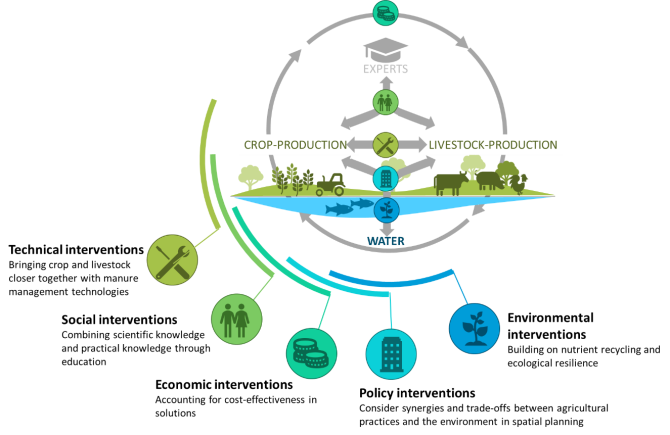
News
Five ways for green agriculture and blue water
Pollution from agriculture negatively affects the natural environment, with iconic problems such as algal blooms and massive fish kills. On the other hand, the rising human population has a great demand for food. This tension between sufficient food production and environmental pressure from agricultural actives asks for a different way of thinking: that of sustainable green agriculture to reach blue water in our lakes, rivers and oceans. Recent research indicates five ways that help to achieve this goal.
Scientists of Wageningen University & Research and Chinese colleagues from China Agricultural University, Chinese Academy of Sciences, Southwest University and Tsinghua University published a perspective article on five ways to reach green agriculture and blue water. The focus of the perspectives is on China, where the government has a strong wish to go from non-sustainable to sustainable “green” practices where enough food is produced and waters are “blue” without pollution. The authors argue a key step in achieving green agriculture and blue water in China is to re-integrate food and animal production as was in the past within China. Five ways can simultaneously help to reach this goal.
1. Implement technologies
The first way deals with actions to implement technologies. The use of already available advanced technologies is important to close the distance between crop and livestock locations. Maryna Strokal, one of the authors, states: “Closing the physical distance between large-scale livestock farms and crop production may, however, be impractical in many Chinese regions for geographical reasons, the high cost of transport, and the social desire to locate livestock farms in the vicinity of high food demanding cities. Advanced technologies, such as manure composting, can help to bring crop and livestock production closer together without reducing their physical distance.” Technologies such as manure composting with bioreactors make manure suitable for transportation over longer distances, for example by removing odors and bacteria.
2. Social interventions
Scientific knowledge is important to combine with practical knowledge. This could be done via education. An already existing example where scientific knowledge has been successfully put into practices with farmers is through the Science and Technology Backyard concept in China. This concept implies that scientists live and work with farmers to grow crops. Farmers appreciate this and receive scientific advice on the right amounts of fertilizers and timing to apply to crops and vegetables to avoid losses of nutrients to the environment. The benefits are less environmental pollution and higher crop yields. Strokal suggests that upscaling such an example to a national level will contribute to sustainable agriculture.
3. Economic interventions
Economic incentives are needed to help farmers to apply manure on land instead of applying synthetic fertilizers. Therefore, we need to search for cost-effective solutions and reduce inequities in the market environment through regulation, taxation and subsidies. Strokal: “Recycling of manure back on land could be a promising, cost-effective strategy and an alternative of dumping into waters. This supports the wish of the national government to facilitate manure recycling.” The Chinese government puts a lot of efforts to facilitate the recycling of manure on the land.
4. Policy interventions
Policies can facilitate sustainable spatial planning by considering synergies and trade-offs between agricultural policies and environmental actions. Strokal et al state: “Such policies could facilitate the implementation of innovative technologies taking into account the social and economic interventions.” It is important to integrate the five ways in policies oriented towards green (sustainable) agriculture and clean water for our future generations. Strokal et al argue that “Scientists and stakeholders can collaborate in the reintegration process through co-operative creation of new ideas, designs or values by integrating their expertise and tools. This will help in the co-development of actionable solutions with the involvement of stakeholders (e.g., local farmers).”
5. Environmental interventions
The authors see an opportunity to combine the four ways above with ecological resilience. Strokal states: “By restoring natural environments such as lakes and rivers and by constructing new wetlands, nature can support our sustainable future.”

The authors conclude that “Scientists and stakeholders can collaborate in the reintegration process through co-operative creation of new ideas, designs or values by integrating their expertise and tools.” This is needed for actionable solutions with the active participation of both scientists and local farmers. Furthermore, as the authors state: “China is unlikely to be the only country for which this is a promising strategy”, so that recommendations could be useful for regions around the world. Further strategies will be studied by Chinese and Dutch researchers of Wageningen University within the SURE+ project.